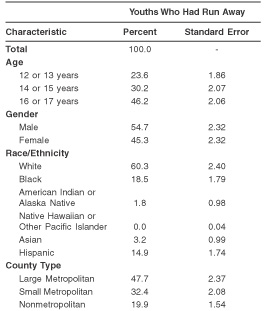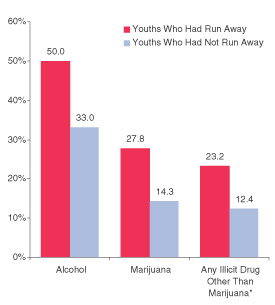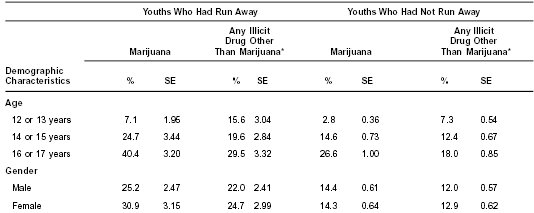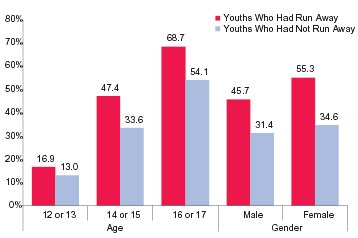
 |
| July 2, 2004 |
|
In Brief |
|
Previous research has shown that alcohol and illicit drug use is higher among youths who have run away from home than among those who do not run away from home.1,2 The 2002 National Survey on Drug Use and Health (NSDUH) asks youths aged 12 to 17 to report whether they had run away from home and slept on the street in the past 12 months.3 NSDUH also gathers information from youths on their use of alcohol or any illicit drug during the year prior to the interview. "Any illicit drug other than marijuana" refers to cocaine (including crack), inhalants, hallucinogens, heroin, or prescription-type drugs used nonmedically. Responses were analyzed by age and gender.
In 2002, approximately 1.6 million youths (7 percent) aged 12 to 17 had run away from home and slept on the street in the past 12 months. Approximately 5 percent of youths aged 12 or 13, 6 percent of youths aged 14 or 15, and 10 percent of youths aged 16 or 17 had run away from home in the past 12 months. Youths aged 12 to 17 who had run away from home in the past 12 months were more likely to be male (55 percent) than female, and nearly half (46 percent) were aged 16 or 17 (Table 1).
Table 1. Demographic Characteristics of Runaway Youths Aged 12 to 17: 2002 |
Figure 1. Percentages of Past Year Alcohol and Illicit Drug Use among Youths Aged 12 to 17, by Runaway Status: 2002 |
 |
 |
The rate of past year alcohol use was higher among youths who had run away from home in the past 12 months (50 percent) than among youths who had not run away (33 percent) (Figure 1). This difference was evident across age groups and for both males and females. The rate of alcohol use among youths aged 14 or 15 who had run away from home was 47 percent compared to 34 percent among youths in the same age group who had not run away (Figure 2). Alcohol use was higher among female youths who had run away (55 percent) than males youths who had run away (46 percent).
The rates of past year marijuana use and past year use of an illicit drug other than marijuana were higher among youths who had run away from home in the past 12 months than among youths who had not run away in the past 12 months (Figure 1). For example, in the past year about 23 percent of youths aged 12 to 17 who had run away had used an illicit drug other than marijuana compared with 12 percent of youths who had not run away.
Among both male and female youths, and across age groups, the rate of illicit drug use was higher for those who had run away in the past 12 months compared to youths who had not run away. For example, youths aged 16 or 17 who had run away were more likely to have used marijuana in the past year (40 percent) than youths aged 16 or 17 who had not run way in the past year (27 percent) (Table 2). Females who had run away in the past 12 months reported a higher rate (31 percent) of marijuana use than females who had not run away (14 percent).
Table 2. Percentages of Past Year Illicit Drug Use among Youths Aged 12 to 17, by Runaway Status and Demographic Characteristics: 2002 |
 |
Figure 2. Past Year Alcohol Use among Youths Aged 12 to 17, by Runaway Status and Demographic Characteristics: 2002 |
 |
Source: SAMHSA, 2002 NSDUH.
* Any illicit drug other than marijuana includes cocaine (including crack), heroin, hallucinogens, inhalants, or any prescription-type drug used nonmedically.
| The National Survey on Drug Use and Health (NSDUH) is an annual survey sponsored by the Substance Abuse and Mental Health Services Administration (SAMHSA). Prior to 2002, this survey was called the National Household Survey on Drug Abuse (NHSDA). The 2002 data are based on information obtained from 11,751 youths aged 12 to 17 who were asked a question on running away from home. The survey collects data by administering questionnaires to a representative sample of the population through face-to-face interviews at their place of residence.
The NSDUH Report is prepared by the Office of Applied Studies (OAS), SAMHSA, and by RTI International in Research Triangle Park, North Carolina. (RTI International is a trade name of Research Triangle Institute.) Information and data for this issue are based on the following publication and statistics: Office of Applied Studies. (2003). Results from the 2002 National Survey on Drug Use and Health: National findings (DHHS Publication No. SMA 03–3836, NHSDA Series H–22). Rockville, MD: Substance Abuse and Mental Health Services Administration. Also available online: http://www.oas.samhsa.gov. Because of improvements and modifications to the 2002 NSDUH, estimates from the 2002 survey should not be compared with estimates from the 2001 or earlier versions of the survey to examine changes over time.
|
| The NSDUH Report (formerly The NHSDA Report) is published periodically by the Office of Applied Studies, Substance Abuse and Mental Health Services Administration (SAMHSA). All material appearing in this report is in the public domain and may be reproduced or copied without permission from SAMHSA. Additional copies of this report or other reports from the Office of Applied Studies are available on-line: http://www.oas.samhsa.gov. Citation of the source is appreciated. |
|
 This page was last updated on May 16, 2008. |
* Adobe™ PDF and MS Office™ formatted files require software viewer programs to properly read them.
Click here to download these FREE programs now
| Highlights | Topics | Data | Drugs | Pubs | Short Reports | Treatment | Help | OAS |